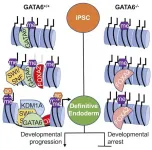Study finds that inflammatory processes are altered in the brains of people with OUD
2021-06-14
(Press-News.org) (Boston)-- Prevalence rates of opioid use disorder (OUD) have increased dramatically, accompanied by a surge of overdose deaths--nearly 50,000 in the U.S. in 2019. While opioid dependence has been extensively studied in preclinical models, an understanding of the biological alterations that occur in the brains of people who chronically use opioids and who are diagnosed with OUD remains limited.
To address this issue, researchers from Boston University School of Medicine (BUSM) have conducted the largest transcriptomic (the study of all the RNA molecules within a cell) study to date using postmortem brains from people with OUD.
Their findings for the first time show a critical role for neuroinflammation as the driver of the pathological brain alterations produced by chronic opioid use. They also identify microglia (the most prominent immune cells of the central nervous system and the first to respond when something goes wrong in the brain) as the cell type responsible for many of these changes.
"Our study has yielded a number of surprising and important findings, including how two of the most critical brain regions associated with opioid dependence, the prefrontal cortex and nucleus accumbens, communicate with one another under "healthy" conditions, as well as how opioids alter fundamental brain processes contributing to opioid dependence," explained corresponding author Ryan W. Logan, PhD, associate professor of pharmacology & experimental therapeutics at BUSM.
To investigate the molecular changes in the human brain associated with opioid dependence, the researchers used transcriptomic and computational approaches to examine gene changes in the prefrontal cortex and nucleus accumbens and discovered changes associated with inflammation and synaptic structure/function in the brains of people who are diagnosed with OUD. "The data reveals a new mechanism by which opioids may alter the brains' structure to change synaptic plasticity, ultimately resulting in behavioral changes," said Logan.
According to the researchers, inflammation in the brain is related to several psychiatric disorders and neurological disorders including neurodegeneration and aging-related brain diseases. "Our findings highlight the potential role for activation of specific inflammatory pathways in the brain and their interplay in brain processes related to cognition, impulsivity, risk-taking and substance use," he added.
The researcher believe this this work offers a new context for neuroinflammatory actions in the human brain that may explain how opioids produce circuit dysfunction. In addition, it may provide new insights into potential targets for therapeutic development in treating people suffering with opioid dependence.
INFORMATION:
These finding appear online the journal Biological Psychiatry.
Funding for this study was provided by the Hamilton Family Prize for Basic Neuroscience Research in Psychiatry at the University of Pittsburgh School of Medicine to R.W.L., NHLBI R01HL150432 to R.W.L, and NIDA R01DA051390 to R.W.L and M.L.S.
ELSE PRESS RELEASES FROM THIS DATE:
2021-06-14
People with end-stage renal disease often undergo hemodialysis, a life-sustaining blood-filtering treatment. To make the process as fast and efficient as possible, many people have "hemodialysis grafts" surgically implanted. These grafts are like bypasses, connecting a vein to a major artery, making it easier to access blood and ensuring the same blood doesn't get filtered twice.
But the grafts have a notorious problem: Clots tend to form where the graft is attached to the vein. For the person undergoing dialysis, this means not only a break from treatment, but also surgery to remove the graft and then surgery to implant another.
A multidisciplinary team from Washington University School of Medicine ...
2021-06-14
Scientists know that developing cells in a healthy embryo will transform into a variety of cell types that will make up the different organ systems in the human body, a process known as cell differentiation. But they don't know how the cells do it.
A Medical University of South Carolina (MUSC) study in Cell Reports led by Stephen Duncan, D.Phil., examines how an endodermal cell - a type of developing cell - becomes a liver cell and not some other type of cell. Duncan and his team found that the development of naive cells into differentiated liver cells ...
2021-06-14
Researchers have developed a new approach to gene therapy that leans on the common pain reliever acetaminophen to force a variety of genetic diseases into remission.
A paper published in Science Translational Medicine describes how the novel technique successfully treated the blood-clotting disorder hemophilia and the debilitating metabolic disease known as phenylketonuria, or PKU, in mice.
The approach uses a benign lentivirus to both correct disease-causing mutations and to insert a new gene that makes liver cells immune to the potentially toxic effects of acetaminophen. The latter ...
2021-06-14
CINCINNATI--The disease is so rare and complex that its acronym is hard to pronounce. But for infants unlucky enough to be born with this lung disease, the outcome is usually fatal.
The disease is called alveolar capillary dysplasia with misalignment of the pulmonary veins (ACDMPV). Research indicates the disease is linked to mutations in the FOXF1 gene. Worldwide, medical experts have documented about 200 cases, but an unknown number of infants may have died without the condition ever being diagnosed, according to the National Organization for Rare Disorders.
The disease is caused by genetic variations that prevent proper blood vessel formation in the lungs. Within ...
2021-06-14
Los Alamos, N.M., June 10, 2021 - For the first time, the boundary of the heliosphere has been mapped, giving scientists a better understanding of how solar and interstellar winds interact.
Video link: https://youtu.be/w__vzNXSFoI
"Physics models have theorized this boundary for years," said Dan Reisenfeld, a scientist at Los Alamos National Laboratory and lead author on the paper, which was published in the Astrophysical Journal today. "But this is the first time we've actually been able to measure it and make a three-dimensional map of it."
The heliosphere is a bubble created by the solar wind, a stream ...
2021-06-14
GAINESVILLE, Fla. --- An international research team has described a new species of Oculudentavis, providing further evidence that the animal first identified as a hummingbird-sized dinosaur was actually a lizard.
The new species, named Oculudentavis naga in honor of the Naga people of Myanmar and India, is represented by a partial skeleton that includes a complete skull, exquisitely preserved in amber with visible scales and soft tissue. The specimen is in the same genus as Oculudentavis khaungraae, whose original description as the smallest known bird was retracted last year. The two fossils were found in the same area and are about 99 million years ...
2021-06-14
What The Study Did: The results suggest assisted living residents experienced increased mortality during the COVID-19 pandemic consistent with increases observed among nursing home residents.
Authors: Kali S. Thomas, Ph.D., of Brown University in Providence, Rhode Island, is the corresponding author.
To access the embargoed study: Visit our For The Media website at this link https://media.jamanetwork.com/
(doi:10.1001/jamanetworkopen.2021.13411)
Editor's Note: The article includes funding/support disclosures. Please see the article for additional ...
2021-06-14
What The Study Did: Researchers examined the association between the amount of ultra-processed food consumed by children and their weight in early adulthood.
Authors: Kiara Chang, Ph.D., of Imperial College London, is the corresponding author.
To access the embargoed study: Visit our For The Media website at this link https://media.jamanetwork.com/
(doi:10.1001/jamapediatrics.2021.1573)
Editor's Note: The article includes funding/support disclosures. Please see the article for additional information, including other authors, author contributions and affiliations, conflict of interest and financial disclosures, and funding and support.
INFORMATION:
Media advisory: ...
2021-06-14
What The Study Did: Differences by sex and race/ethnicity in suicidal thoughts and nonfatal suicide attempts among U.S. adolescents over the last three decades were assessed in this survey study.
Authors: Yunyu Xiao, Ph.D., of Indiana University-Purdue University in Indianapolis, is the corresponding author.
To access the embargoed study: Visit our For The Media website at this link https://media.jamanetwork.com/
(doi:10.1001/jamanetworkopen.2021.13513)
Editor's Note: The article includes conflicts of interest disclosures. Please see the article for additional information, including ...
2021-06-14
Diseases that affect tubular structures in the body, such as the gastrointestinal (GI) system, vasculature and airway, present a unique challenge for delivering local treatments. Vertically oriented organs, such as the esophagus, and labyrinthine structures, such as the intestine, are difficult to coat with therapeutics, and in many cases, patients are instead prescribed systemic drugs that can have immunosuppressive effects. To improve drug delivery for diseases that affect tubular organs, like eosinophilic esophagitis and inflammatory bowel disease, ...
LAST 30 PRESS RELEASES:
[Press-News.org] Study finds that inflammatory processes are altered in the brains of people with OUD




